|
|
Bay Ronald

|
|
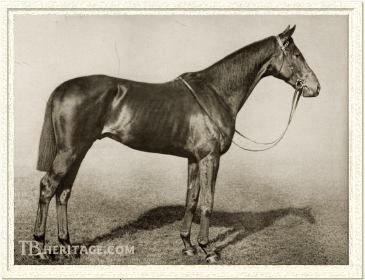 |
|
|
Bay Ronald was a moderately good racehorse who, unlike his staying sire, Hampton, could not run beyond 1-1/2 miles. Never especially robust, he nonetheless ran for four seasons with top company. Little was really expected of him at the outset of his breeding career and he had limited access to top quality mares; despite this, he became an influential stallion who continued the Hampton sire line, getting two top sire sons in England, and a good sire son in France.

Bay Ronald was foaled on May 3, 1893 at Leybourne Grange Stud. His sire, Hampton, was 21 at the time of Bay Ronald's birth, and had already sired classic winners Ayrshire, Merry Hampton, and Reve d'Or. Hampton's fourth classic champion, Ladas, would win the Epsom Derby in the year following Bay Ronald's birth. |
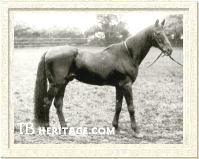
Hampton
| |
Dam of Bay Ronald was the Galliard mare, Black Duchess. Galliard was a Two Thousand Guineas winner and a son of the Derby winner Galopin, who also sired the unbeaten racehorse and great sire, St. Simon. The dam of Black Duchess, Black Corrie, was by Sterling, sire of Isonomy. Black Duchess produced eight foals before dying in 1908, all of them winners. In addition to Bay Ronald, she was also the dam of Black Cherry (by Bendigo), who produced two fillies -- Cherry Lass, winner in 1905 of the One Thousand Guineas and Oaks, and Blanche, dam of Blandford, three times a leading sire in the 1930s and sire of four Epsom Derby winners. |
Bay Ronald, being a late foal, was small, and when sent to be sold at the Doncaster yearling sales, failed to reach his reserve of 500 guineas. He was then purchased privately by Tom Jennings, Jr., son of the trainer of the great French runner Gladiateur, for Mr. (later Sir) Leonard Brassey. The price tag was £500, a little less than the original 500 guineas asked for at the sale.
Bay Ronald had a long racing career in which he won only five of his twenty-six starts. But his owner thought very highly of him and never thought twice about placing him against top company.
Whereas Hampton had been able to win a tiny maiden stakes and two selling races as a juvenile, Bay Ronald could not even do that. He started five times at two, finished third once and unplaced in the remainder. At three, Bay Ronald won two of eight. He had unplaced runs to Persimmon in both the Derby and the Jockey Club Stakes, but notched his first victories in the autumn, taking the 1 mile Limekiln Stakes and the 1-1/2 mile Lowther Stakes at Newmarket.
At four, Bay Ronald had an uninspiring record of one win from six starts, his lone victory coming in the 1-1/2 mile Hardwicke Stakes at Royal Ascot, in which he carried 133 pounds. He improved enough from the form of his previous seasons to run decently with the best. He placed third to Persimmon and Velasquez in the Eclipse Stakes, and second to Velasquez in the Champion Stakes.
At five, Bay Ronald won two of seven. He won the 1-1/4 mile City and Suburban Handicap, and recorded a brilliant victory under 132 pounds in the Epsom Cup. These two wins sparked hope he might stay the 2-1/2 mile trip of the Ascot Gold Cup. He underwent "severe preparation" for it over hard ground, and was unable to stay for the race, won by the great French stayer, Elf II. Bay Ronald was a courageous campaigner, and his owner did not believe in keeping him in cotton wool. Bay Ronald came out the following day to finish a gallant second to Collar in the Hardwicke Stakes, and later in the season ran Velasquez to a length, at level weights, in the Champion Stakes.
Bay Ronald in the Stud
Bay Ronald was retired following the end of the 1898 racing season. On the track, he had proved he was well below classic form, but he was game and honest, and won a total of £6,443, a goodly sum for the era. Though he failed in the Ascot Gold Cup, he could get 1-1/2 miles and could carry high weights. Upon entering the stud ranks, he would certainly not become fashionable, but he came up with some very talented individuals, and passed along stoutness. Most importantly, Bay Ronald passed along the genes of the Hampton male line to further generations, for he was to prove to be the most important breeding son of his sire, Hampton. Yet all this was in the future when Bay Ronald entered stud in 1899 at Preston Farm, near Aylesford, Kent, at a fee of 25 guineas, dams of winners free. Eventually, by 1905, Bay Ronald's fee rose to 100 guineas. During his career in Britain, he was never bred to more than twenty mares a season, and on his owner, Mr. Brassey's admission, "many of them were of doubtful quality."
In England, Bay Ronald started his caraeer with five two-year old winners in his first crop, three of them owned by Brassey. Brassey's Merryman, by Bay Ronald, won the Sandown Park Produce Stakes and the Woodcote Stakes. His next crop included Wild Oats, a winner of the Rous Memorial Stakes at Ascot, and six other winners. The following year's crop produced six small winners in 1905, and he was then sold to a French breeders syndicate, and put in Cheri Halbronn's stud in France. At the time of his sale, his two most influential sons had not yet reached the turf: Bayardo was in utero, and Dark Ronald was a yearling. These two sons proved to be the best of Bay Ronald's get in England, and he went on to sire some useful animals in France.
|
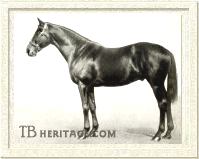
Dark Ronald
| |
DARK RONALD, foaled in 1905 from the non-winning Thurio mare, Darkie, was a handsome bay colt plagued with soundness problems. He was bred by Edward Kennedy, later noted as the breeder of The Tetrarch, and was purchased by Sir Abe Bailey for 1300 guineas at the Doncaster yearling sale.
Dark Ronald was stout, and possessed some measure of speed as well. At two, Dark Ronald captured the five furlong Hurst Park Foal Plate. Lameness kept him on the shelf after his juvenile season for nearly two years, but when he came back, he displayed remarkable versatility. At Royal Ascot, Dark Ronald captured the seven furlong Royal Hunt Cup and then the Princess of Wales Stakes at 1-1/2 miles.
|
| At stud, >DARK RONALD spent some time in England, where he sired Son-in-Law, a great stayer and progenitor of a staying male line which over the years included Beau Pere, Foxhunter, Marsyas II, Tiberius, and Herbager. Other sons gotten by >DARK RONALD while in England include the full brothers, Ambassador IV and Brown Prince II, each of whom wound up in the United States for stud duty, and Dark Legend, who had a good stud career in England. But it was in Germany where >DARK RONALD excelled. Sold to the German National Stud on the eve of the first World War in 1913, >DARK RONALD led the German sire list five years running, 1918-1922. In Germany, >DARK RONALD sired dual classic winner Prunus, German Derby champion Herold, and Wallenstein, among others. Each of these sons led the German sire list, Prunus doing so five times. |
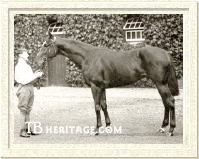
Bayardo
| |
BAYARDO, foaled in 1906, was bred and raced by Alfred Cox. Bayardo was out of Galicia, a daughter of Galopin. Bayardo was one of the most brilliant runners ever seen in Britain. He won the St. Leger after running unplaced in both the Two Thousand Guineas and Derby Stakes. During his career, Bayardo captured 22 of 25 starts, and after his disappointing loss in the Derby, reeled off fifteen victories in succession between the latter half of his three-year-old season and the end of his four-year-old season. Among his victories were the Champion Stakes, Limekiln Stakes and Ascot Gold Cup.
|
| At stud, BAYARDO was an enormous success from the outset. He was leading sire in 1917 and 1918 and leading broodmare sire in 1925. He sired three classic winners--Oaks heroine Bayuda, and two winners of the English Triple Crown,Gay Crusader and Gainsborough. Gay Crusader was not too successful as a stallion, but two of his daughters produced Prince Rose and Djebel, respectively. Gainsborough sired four classic winners, including Hyperion and Solario. Hyperion became a tremendous stallion, leading the English sire list six times and the broodmare sire list four times. Sadly, Bayardo, who had proven such a potent stallion, did not have a normal life span, as he died from thrombosis in 1917 at the age of only eleven.
|
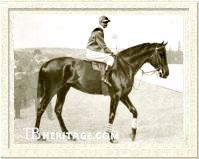
Macdonald II
| |
In 1900, during his second season at Preston Farm, French breeder Prince Pierre d'Arenberg was looking for a stallion for his Barcaldine mare, Myrtledine. Brassey suggested Bay Ronald, and the Prince duly agreed to the mating. The resultant foal, a colt, was foaled the following spring. Named MACDONALD II, he became a top class runner in France, his wins including the Prix de Sablonville, the Prix du Conseil Municipal, the Prix Royal Oak, the Prix Boiard (twice), and the Furstenberg Rennen in Germany. Macdonald II also finished second in the Prix du Jockey Club. At stud, Macdonald II sired Grand Prix de Paris winner As d'Atout and other good horses.
|
The success of Macdonald II was the spark which spurred the purchase of Bay Ronald for stud duty in France, and Mr. Brassey sold his stallion for £5000. Bay Ronald sired several good runners in Europe, and many of them were first class stayers. Among them were COMBOURG, winner of the Prix Royal Oak and the Prix du Cadran, the French versions of the St. Leger and Ascot Gold Cup, respectively; GREFFULHE, winner of the Prix Noailles; and FIDIA, winner of the Gran Premio di Milano in Italy.
As a sire of broodmares, Bay Ronald came up with daughters who passed along their sire's male line's characteristic stoutness to their offspring. Daughters of Bay Ronald included: ROSE RONALD, dam of Gimcrack Stakes winner Lily Rose; DELAGOA BAY, dam of Zbaraz (by Hapsburg), winner in Poland of the Nagroda Rulera, the Nagroda Ludwicka, the Nagroda Prezydenta Rzeczypospolitej (over 3200 meters), and the Polish St. Leger; PHILOSOPHY, dam of Le Prodige, winner in France of the Prix Ganay, Prix du Conseil Municipal, Prix du Cadran, Prix des Sablons, and the Prix Edgard Gillois (over 3800 meters); SHAMROCK, dam of Scarabae, winner in Germany of the Ratibor Rennen; GAZZA LADRA, dam of Gave, winner of the Prix Jean Prat (2000 meters); and MARION DELORME, dam of Mirebeau II, winner of the Grand Prix du Printemps.
The most renowned daughter of Bay Ronald was RONDEAU. Out of the Bend Or mare Doremi, Rondeau was bred by Sir John Robison at Workshop Manor Stud.
|
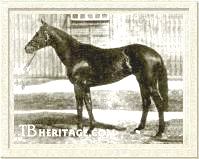
Grandson Zbaraz was a top racehorse in Poland.
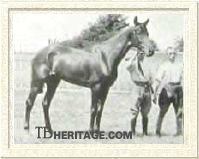
Daughter Rondeau
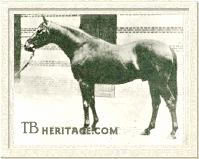
Rondeau's son Teddy was a champion in Spain and later an influential sire. | |
As a two-year-old in 1902, Rondeau raced eleven times. She proved a very useful filly, for after winning two selling plates, she won the Plantation Stakes at Newmarket by a neck, the Hardwicke Two-Year-Old Stakes at Newmarket by two lengths, and the Prince of Wales's Nursery Handicap at Stockton. She also placed four times. At three, she was not up to classic standard, but she won her share in nine starts, including the Lowther Stakes, the Dullingham Stakes at Newmarket, and the Champion Breeders' Biennial Foal Stakes at Derby. She ran four times at four, and won the Dullingham Stakes for the second year running and placed second in the Cesarewitch Handicap and a Royal Plate at Derby.
During her career, Rondeau changed hands several times, and in 1906 she was owned by Sir James Miller, owner of Triple Crown champion Rock Sand. Following his death, Rock Sand was purchased by August Belmont and sent to the United States. Rondeau, in foal to Rock Sand, was purchased by French breeder Edmund Blanc. For Blanc, the decision to purchase her must have seemed ill advised, for her Rock Sand foal died in infancy, and her next, Rossini, by Flying Fox, never raced. Three dead foals in succession followed before she gave birth to Karimah, another unraced offspring of Flying Fox. Her fortunes changed in 1913 when Rondeau foaled a bay colt by Flying Fox's son, Ajax.
Named Teddy, he was sold for a small price to Jefferson Davis Cohn and sent to race in Spain, racing in France severely limited due to the raging World War. Teddy raced eight times and won six races, including the Premio Villamejor, (the Spanish St. Leger). Teddy was named champion three-year-old colt in Spain in 1916.
At stud, he became highly influential. Sons Sir Gallahad III and Bull Dog, full brothers out of the Spearmint mare Plucky Liege, were exported to the United States and became leading sires. His daughter, La Troienne became one of the most significant broodmares in history, with nearly a thousand stakes winners descending from her in tail-female.
|
In the 1930s, aging Teddy himself was exported to the U.S., and sired two more influential sons -- Sun Teddy, whose male line culminated with Damascus and Private Account, important sources of stamina, and Case Ace, broodmare sire of Raise a Native.
Bay Ronald died in May, 1907 at the early age of fourteen. At the time, though his loss was keenly felt, the magnitude of it was not realized until ten years later when his best son, Bayardo, also suffered a premature death. What might have been had father and son been blessed with normal life spans is one of the great "what ifs" of breeding history. But Bay Ronald left a lasting legacy, nonetheless, for his sons Bayardo, Dark Ronald, and Macdonald II each ensured the continuation of the Hampton sire line.
--Liz Martiniak |
|
|
|

